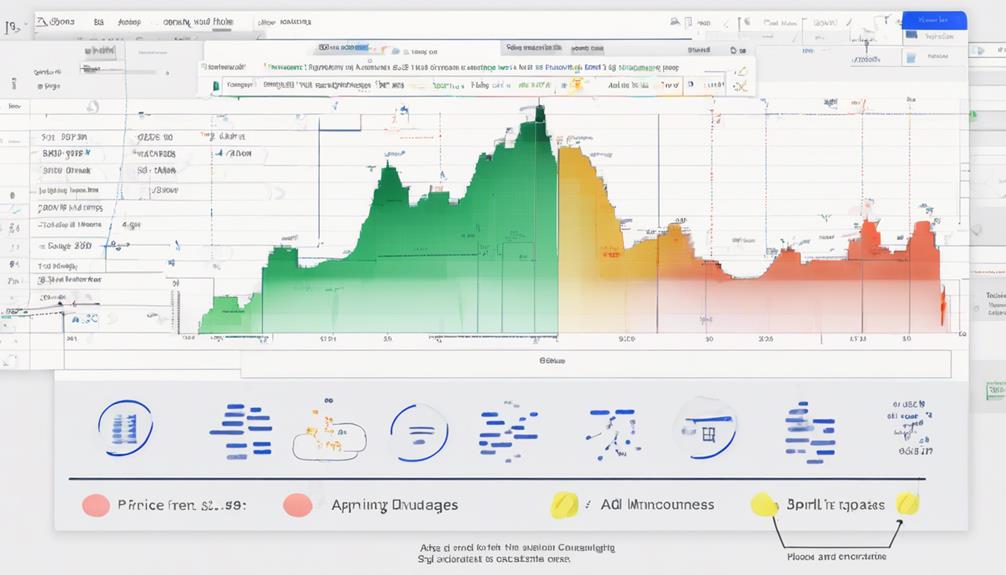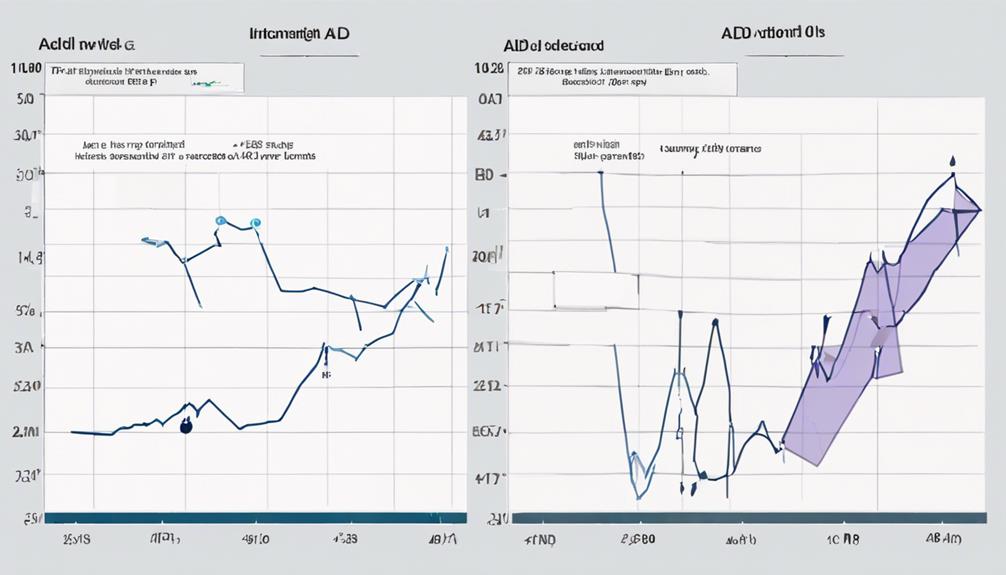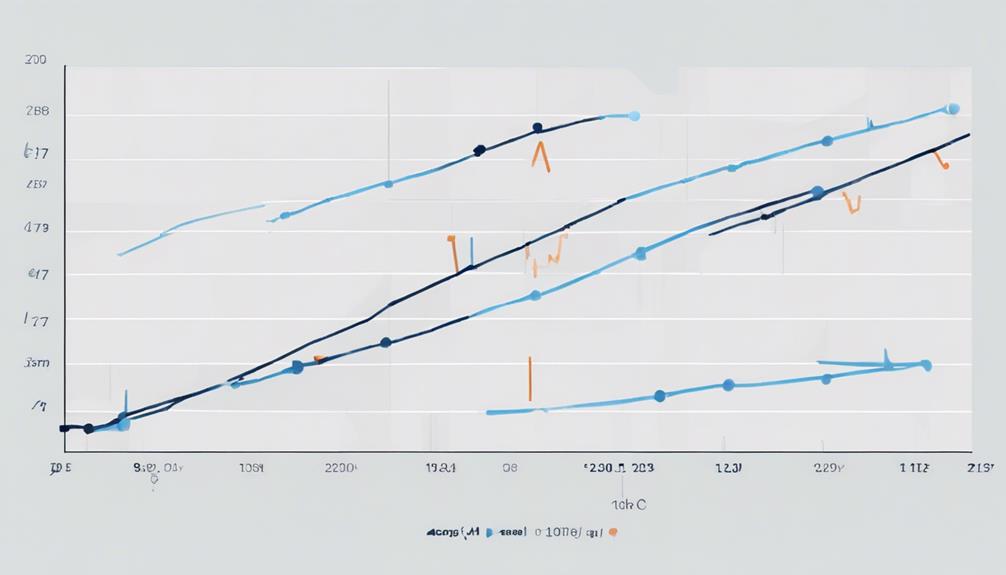When it comes to interpreting the ADL Indicator, remember that 'knowledge is power.' Understanding the intricacies of this tool can be a game-changer in your trading endeavors.
By mastering the three-step guide outlined in this discussion, you will gain insights into market trends, identify potential signals for strategic moves, and enhance your overall trading acumen.
So, how can this knowledge elevate your trading performance and decision-making processes?
Understanding ADL Indicator Components
To understand the ADL indicator components effectively, focus on grasping the calculations behind Money Flow Multiplier (MFM), Money Flow Volume (MFV), and the Accumulation Distribution Line.
The Money Flow Multiplier (MFM) is a key component calculated using a formula that considers the relationship between the high, low, and closing prices. Money Flow Volume (MFV), a volume-based indicator, is then determined by multiplying the Money Flow Multiplier (MFM) by the volume during that period.
The Accumulation Distribution Line (ADL) integrates the current Money Flow Volume (MFV) with the prior period's ADL to showcase the flow of money in and out of a security. These components provide insights into buying and selling pressure, allowing for a nuanced interpretation of the market dynamics.
Calculating the ADL Indicator

Now, let's move on to understanding how to calculate the ADL indicator, a crucial step in interpreting market dynamics based on buying and selling pressure.
To calculate the ADL indicator efficiently, consider the following:
- Use price and volume data to determine the net money flow.
- Multiply the Money Flow Multiplier (MFM) by the period's volume to obtain the net money flow.
- Add the previous ADL value to the current net money flow to derive the new ADL value.
Interpreting ADL Indicator Trends

When interpreting ADL Indicator trends, focus on aligning them with price action to confirm market dynamics effectively. The ADL indicator trends, when in sync with price action, can provide valuable insights into market breadth and sentiment.
Higher highs and lows on the ADL line typically indicate an upward trend, while lower highs and lows suggest a downward trend. Understanding the relationship between the ADL line and the index can help confirm prevailing market trends, guiding trading decisions.
Recognizing ADL Indicator Divergence

Recognizing ADL indicator divergence can provide valuable insights into potential shifts in market sentiment and guide strategic trading decisions effectively.
When observing ADL indicator divergence, consider the following:
- Bullish Divergence: Indicates potential upward price movement despite bearish price action.
- Bearish Divergence: Signals possible downward price movement even with bullish price action.
- Sign of Reversal: Divergence between price and ADL may suggest a weakening trend or an upcoming reversal.
What Are the Three Steps to Interpreting the ADL Indicator?
When interpreting the comprehensive ADL technical indicator, follow these three steps. First, identify the trend by analyzing the indicator’s line movements. Next, look for confirmation from other technical indicators. Lastly, consider the volume of trades to validate the strength of the trend.
Can Understanding ADL in Technical Analysis Help with Interpreting ADL Indicators?
Understanding ADL in technical analysis is crucial for interpreting ADL indicators. ADL, or accumulation distribution line, helps traders gauge the supply and demand for a particular security. By assessing the trend of ADL in technical analysis, traders can make informed decisions about when to buy or sell a stock.
Using ADL Indicator in Trading Strategies

Utilize the ADL indicator in your trading strategies to validate trends and forecast potential reversals based on market breadth. The ADL line, derived from the accumulation distribution strategy, gauges the flow of money into or out of a security by analyzing price and volume.
By comparing the AD line to price movements, traders can generate valuable trading signals and assess the strength of a trend. Divergences between the ADL indicator and price charts offer insights into potential trend shifts, aiding in decision-making processes.
Integrating the ADL indicator with other technical analysis tools enhances the effectiveness of trading strategies. Stay attuned to the AD indicator's dynamics to make informed trading decisions and optimize your market analysis approach.
Frequently Asked Questions
How Do You Use the ADL Indicator?
To use the ADL indicator, you analyze money flow trends to gauge buying or selling pressure. Rising values signal demand, while falling ones indicate supply. By interpreting ADL, you can anticipate market movements and make strategic trading decisions.
How Do You Interpret Accumulation Distribution Indicator?
When interpreting the Accumulation Distribution Indicator, focus on positive values indicating buying pressure and negative values suggesting selling pressure. Keep an eye on how the indicator fluctuates around the zero line for insights into market trends and potential reversals.
How Do You Read a Moving Average Indicator?
To read a moving average indicator, focus on its trend direction and strength. Shorter averages react quickly to price changes, while longer ones offer a broader view. Look for crossovers where short-term average crosses above or below long-term average for trend change signals.
What Is an ADL Chart?
An ADL chart displays the Advance-Decline Line's movement, revealing market breadth and sentiment. Rising ADL signals bullish sentiment, while falling ADL suggests bearish sentiment. It helps confirm or contradict market trends by analyzing ADL and the index relationship.
Conclusion
Now that you understand the components, calculation, and interpretation of the ADL indicator, how will you incorporate this powerful tool into your trading strategies?
By recognizing trends, confirming divergences, and generating trading signals, the ADL indicator can help you make informed decisions in the market.
So, are you ready to take your trading to the next level with the ADL indicator?
